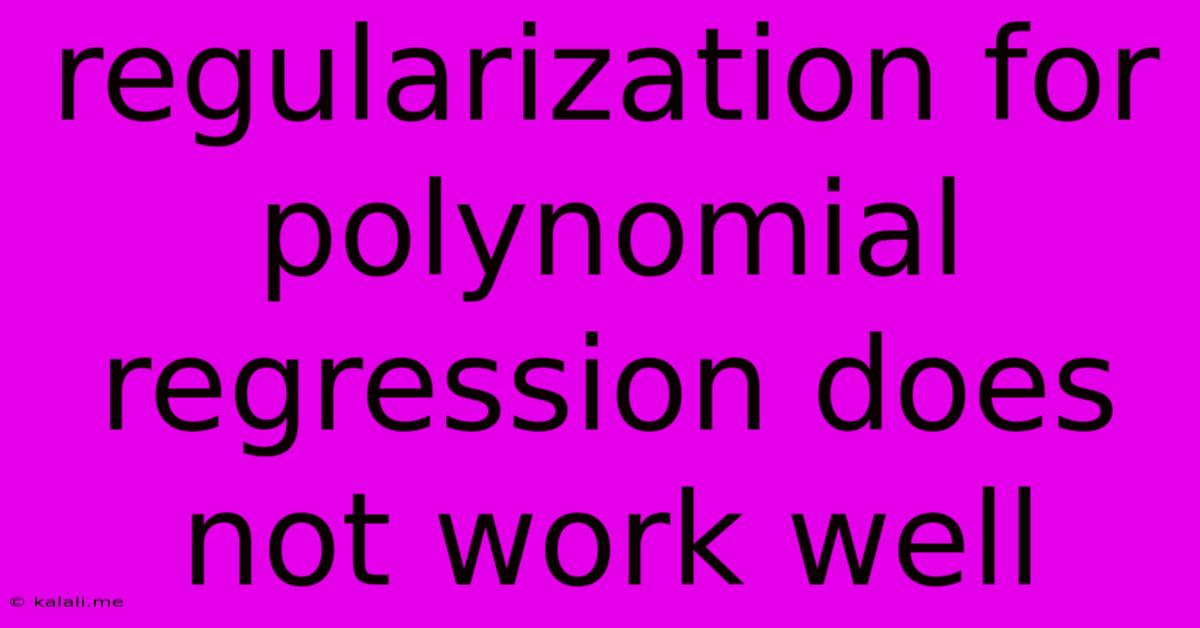Regularization For Polynomial Regression Does Not Work Well
Kalali
May 23, 2025 · 3 min read

Table of Contents
Why Regularization Often Fails in Polynomial Regression: A Deep Dive
Regularization techniques, like Ridge and Lasso regression, are powerful tools for preventing overfitting in many machine learning models. However, their effectiveness is significantly diminished, and sometimes completely fails, when applied to polynomial regression, especially with high-degree polynomials. This article delves into the reasons behind this limitation and explores alternative strategies for handling overfitting in polynomial regression. Understanding this nuance is crucial for anyone working with polynomial models and aiming for robust, generalizable predictions.
The Overfitting Problem in Polynomial Regression
Polynomial regression models, by their very nature, are highly flexible. Higher-degree polynomials can fit incredibly complex datasets, capturing even the minutest fluctuations in the data. This flexibility, while seemingly advantageous, is a double-edged sword. When a high-degree polynomial is used with a limited dataset, the model is prone to overfitting. The model learns the noise in the training data, rather than the underlying trend, resulting in poor performance on unseen data.
This is where regularization techniques are usually employed. Ridge and Lasso regression add penalty terms to the loss function, discouraging overly large coefficients. The intuition is that large coefficients contribute to the model's complexity and its susceptibility to noise. By shrinking the coefficients, the model becomes simpler and less prone to overfitting.
Why Regularization Doesn't Always Work with Polynomials
The inherent problem lies in the nature of polynomial features. When you transform your input data into polynomial features (e.g., x, x², x³, x⁴…), you introduce a high degree of correlation between these features. Features like x and x² are inherently related; as x increases, x² increases quadratically.
Regularization techniques, particularly Ridge regression, are sensitive to multicollinearity (high correlation between predictor variables). In the presence of high multicollinearity, the coefficients become unstable and difficult to estimate accurately. The penalty term in Ridge regression tries to shrink all coefficients, but this can be counterproductive when dealing with correlated features because the model struggles to determine which coefficients are truly important and should be penalized more heavily. The effect of the penalty term gets diluted among the highly correlated features.
Lasso regression, while offering some advantages over Ridge regression by performing feature selection (setting some coefficients to exactly zero), also struggles significantly with highly correlated features generated by polynomial transformation. The model becomes less capable of discerning which correlated features truly contribute to the model's predictive power.
Alternatives to Regularization in Polynomial Regression
Given the limitations of regularization, alternative approaches are necessary to address overfitting in polynomial regression:
-
Feature Selection: Instead of relying on all polynomial features, carefully select a subset of the most relevant features. This can be done through techniques like forward selection, backward elimination, or recursive feature elimination. This reduces the dimensionality of the problem and diminishes the impact of multicollinearity.
-
Lower-Degree Polynomials: Consider using a lower-degree polynomial. While a higher-degree polynomial might seem tempting to capture complex relationships, it often leads to overfitting. Start with a simpler model and gradually increase the degree only if necessary, carefully monitoring performance on a validation set.
-
Data Augmentation: Increasing the size of your dataset can often improve the generalization capability of the model. More data allows the model to learn the underlying pattern more effectively, reducing the influence of noise.
-
Cross-Validation: Employing robust cross-validation techniques like k-fold cross-validation is crucial to obtain reliable performance estimates and avoid overfitting.
Conclusion
Regularization methods, while generally successful in other contexts, often fail to effectively prevent overfitting in high-degree polynomial regression due to the inherent multicollinearity introduced by polynomial feature transformation. Focus instead on feature selection, using lower-degree polynomials, data augmentation and rigorous cross-validation to achieve better results with polynomial models. Understanding these limitations is crucial for building robust and reliable predictive models.
Latest Posts
Latest Posts
-
How To Mark Resources In Fallout 4
May 23, 2025
-
How Long Does Google Keep Deleted Emails On Their Servers
May 23, 2025
-
Another Word For A Man Who Sleeps Around
May 23, 2025
-
Abide In Me And I In You
May 23, 2025
-
Latex How To Do Bullet Points
May 23, 2025
Related Post
Thank you for visiting our website which covers about Regularization For Polynomial Regression Does Not Work Well . We hope the information provided has been useful to you. Feel free to contact us if you have any questions or need further assistance. See you next time and don't miss to bookmark.